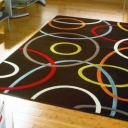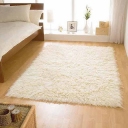Credits : Momina Sibtain
 The carpet industry has undergone substantial changes in the last few decades. Here is an extract from a conversation between The Express Tribune and the Managing Director of Abbas Corp. published in the Express Tribune, June 7th, 2012.
The carpet industry has undergone substantial changes in the last few decades. Here is an extract from a conversation between The Express Tribune and the Managing Director of Abbas Corp. published in the Express Tribune, June 7th, 2012.
LAHORE
Today luxury and affluence is plastered on the walls in the form of art work; exquisite, and often rare, paintings and tapestries are the focus of interior decoration. However, there was a time when the floors of houses were the most beguiling feature of a residence.
Investment in floor mats and rugs was one’s top priority, as they were considered pivotal in adding oomph to interiors. With the recent developments in the carpet market, however, show that the very popular vintage hand-knotted Persian rugs are back and have now become somewhat of a collectors’ item.
Abbas Corporation remains to be one of the leading exporters of hand-knotted carpets who have managed to find demand in countries like the US. The Express Tribune talks to the Managing Director of Abbas Corp. to get a better understanding of the trends that have changed the production pattern of carpets worldwide.“Fine carpets are timeless but even then traditional carpets are not popular anymore,” says Abbas. “The trends usually generate in Milan and New York and then spread out into the international market.”
Carpets are now considered to be fashion accessories and local markets are trying hard to keep up with the international trends. The three main carpet concepts that have taken over the weaving industry are: the IKAT, Suzani and the colour reform revolution.
“ABC Carpet & Home are the trendsetters, who have worked a lot in Turkey where the colour reform revolution came about. In this design concept, carpets are over-dyed so that their designs fade away and remain minimally visible.”
Upon delving more into the theory and the business of carpet weaving, it has become apparent that wild funky designs are what sell these days. Colours such as fuchsia, magenta, purple and blue are being preferred in the markets abroad. IKAT is essentially an Uzbek concept whereby one tie-dyes and weaves yarn to create an intricately designed fabric.
“Trends in interiors have gone from heavily embellished to overly minimalistic and that is the reason why vibrant carpets are now in demand. These rugs add colour and the X-factor to the room.” The common notion that thinner and more rugged carpets have more value is more of a misconception. Finer carpets can be trimmed to make them even thinner but according to the latest trends in the interior decoration department, shaggy carpets are in fashion these days.
Perpetual slump
Despite the exclusivity and beauty of hand-knotted carpets, they are still an under appreciated commodity. With newer and more lucrative opportunities available in the market, the weavers tend to quit, leaving the industry low on resources and labour. “Weaving is a very tedious and skillful craft and requires patience and diligence. The tediousness of the job has forced people to run off to easier employment opportunities and make better money. Women, however, still enjoy weaving because for them it is also a social activity,” Abbas states.
In the early 1990s, China used to be the leading manufacturers of hand-knotted carpets but after the industrial revolution hit China, the weaving business came to an end. The same is the case with India. “Even though people associate high value to hand-knotted carpets in Pakistan and India, there is still no future for this industry in the subcontinent,” claims Abbas.






















